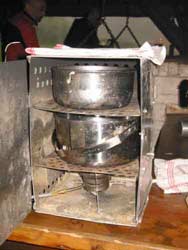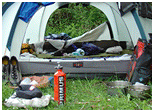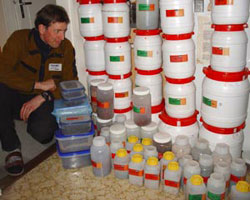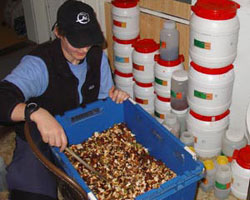- Expeditions
- Short Bike Tours
- Sportive Events
- Trekking
- Mountaineering
- Tours in Tibet
- Tours Kamchatka
Unsorted List
Expedition food
Cycling difficult tracks or hiking remote regions takes a lot of energy
which has to be returned to the body.
Thereby, the ratio of small volume and light weight to high energy content
is essential since everything has to be carried... This is especially important
if you are traveling to remote regions with no possibility of resupply.
Finally, taste is also very important: If food is well organized, tasty
and enough, there is less aggression within the group after tough days.
In fact: Many historic and present expeditions failed due to not well prepared diet plan.
Outdoor cooking is fun |
 |
The cooking-box: a foldable box made of aluminum with two levels for pots. It was designed as a modified form of a Nansen cooker to be able to efficiently melt snow and icein the second level pot. It fits nicely over our fuel stove. |  |
| The cooking box was developed by Andy and Gottfried for their bicycle tour on the frozen sea of Northwest Greenland. It has been heavily used since then, and is a companion on almost every trip. Although taking the cooking box is additional weight, it makes the evening task of cooking more enjoyable... More importantly, it saves fuel consumption, and we can even use it as a kind of oven for baking bread! It is also suitable to dry some things on the warm top. | ||
A list of some of the food items we regularly take on our tours, a lot of them are self-prepared beforehand: |
Vegetables and fruit contain in average 90% of water, therefore dehydrated food is an efficient way to reduce weight and volume. In addition dehydration is a method of food conservation. If done carefully, the contentent of minerals and most vitamines is preseved as well. We prepare all the dehyrated stuff ourselves according to our taste.
 Our stock of dried fruit and vegetables |
 Preparing dried vegetable mix for a 11-week tour |
| dried vegetables | vegetables
contain a lot of minerals and vitamins, legumes are rich in protein.
It makes every meal richer in nutrients and taste. We prepare a diversity of 15 different vegetables by ourselves and mix it according to calories and taste. |
| dried fruit and fruit leather | rich
in carbohydrates, very tasteful. In some countries a good selection of dried fruit is available. |
| mixture of nuts and raisins | a perfect
snack during the day. Depending on the region of travel, different nuts can be bought on local markets. |
| self-made energy bars | a mixture of cereals,
oat meal, and nuts baked with honey. We do prepare them for every tour, but if we are going to remote regions with colder climate they are a great lunch. |
| marzipan | a compact mix of
ground almond with sugar, it makes a perfect energy source (fat and
carbohydrate) during the day. We prepare it ourselves for travels in remote regions. |
| pemmikan | a high
energy food invented by the North American Indians. It consists of ground
dehydrated meat, pork lard ("Schmalz"), brown sugar, and wild
berries or onions. It sounds a litte strange but together with bread
or with a good sauce it makes a great meal. We prepare it ourselves, especially for regions with cold climate and winter tours. |
| full cream milk powder | essential on all of our tours: it goes with the cereal breakfast, is used to prepare tasty sauce to go with the evening meal. In addition, our favorite drink on tour is hot milk with sugar. |
| dehydrated yeast
(to make cake and bread) |
fresh bread together with dried fruit and nut mix makes a perfect lunch, and flour is available almost everywhere. |
| oil | Olive oil is a good energy source to go with bread |
| carbohydrate
source: rice, cous-cous, pasta, potato, etc. |
Depending on what is available on local markets |
| cereal mix or semolina | For tours in remote regions we prepare large amounts of special cereal mix before the tour, otherwise buy things locally. |
| Local markets are
a good source of fresh and interesting stuff worthwhile trying out! |
|
| diet
plan optimized for cold regions; pdf (Andy's food
plan for Greenland) Ernährung auf Wintertouren; pdf (Andys Proviantplan für Grönland) |
|
 |
For touring in high altitude or hot climate we supplement our diet with special products: mineral/vitamin powders, special energy breakfast packs and energy bars |
Links to other travel food related websites: |
Links to other websites with suggestions about food for cycling and trekking:
www.trekking-mahlzeiten.de:
Germann distributor of dehydrated instant meals
An article about expedition
food (by Katherine Jones)
Recepies
optimized for tavelling in South America (collected by Iris and Tore)
